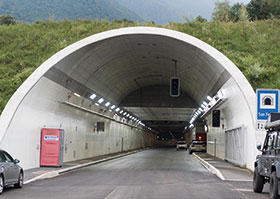

The heavily used main A13 road runs through the town of Roveredo in Switzerland, where the high traffic volumes had begun to take a heavy toll on the quality of life of residents. To bypass the town, the Swiss traffic authorities worked in collaboration with a specially formed consortium to construct a new 2,5 kilometre tunnel, which was opened in November 2016. The project, implemented using Siemens solutions, set new standards in the field of linking control technology to an existing traffic management system. By creating more integrated system architectures, the solution has improved safety for all tunnel users.
Standardised communication solution
A consortium comprising the company Rigamonti, a specialist in the control of lighting systems and tunnel system automation, and IT Professional Sopra Steria joined forces with the Swiss Road Traffic Authority Astra to implement the project. The challenge they faced was to integrate systems and hardware such as fans or fire sensors sourced from completely different suppliers into a single system. A key aspect in implementing the project was also that of communication – firstly within the control system itself, and secondly with the higher-level control system operated by the Canton. In addition, as the tunnel passes directly under the border between Ticino and Grisons, communication is also vital with both control centres.
To achieve the greatest possible degree of integration and transparency, an Open Unified Architecture (OPC UA) interface serves as the standard bridge to external system controls. Initially, this will be temporarily implemented using a Simatic Microbox with Simatic Net OPC UA server connected between the Simatic S7 1500 and the control system. This is set to change in future to enable direct access over the TIA Portal V14 to the OPC UA server of the S7-1500, which will permit simple connection of any optional client. Communication between the client and server can be secured if required by encryption of the data traffic. The TIA Portal V14 will offer facility to either generate certificates or import them from clients. As diverse hardware can be linked to the control system with OPC UA, integration of the overall system is enhanced using this solution, making handling considerably simpler and improving reliability.
Reliable control, simple engineering
The control system for the entire tunnel is based on the Simatic portfolio from Siemens, which CEO Alfredo Rigamonti considers ideally qualified primarily due to its reliability and future-proof design. The lighting, signalling systems (for instance for the escape routes), ventilation and several additional facilities are all automated by the Simatic S7-1500 Controller. For the individual tunnel sections, Arge relies on the local Central Processing Units (CPU) S7-1511 and S7-1515, which in turn are governed by the central Controller S7-1516 as the higher level control system. The Simatic controllers enable compliance with the high availability requirements of the tunnel system and also meet the stringent safety regulations. A Simatic S7-1500 controller is used, for instance, to process signals from the smoke detectors and the Siemens FibroLaser technology installed in the tunnel. The FibroLaser linear heat detection system reacts to heat and enables the rapid, reliable detection of fire sources. In the event of fire, ventilation dampers are opened and fans switched on to extract smoke. Controllable steel fans also guide fresh air into the tunnel at both ends. The controllers are operated using Simatic HMI Comfort Panels. Astra and Arge also opted to use Siemens technology for the distributed I/O, with the Simatic ET 200SP and ET 200MP. Alongside the high availability and reliability of the technical facilities, the Siemens solution also scores when it comes to programming simplicity with the engineering framework TIA (Totally Integrated Automation) portal. Compared to alternative solutions, this allows up to 25 percent time savings.
A decisive factor in achieving this enormous time saving was the completely redesigned SCL (Structured Control Language) editor. “The pre-processed commands which can be accessed from the command library do away with the need for laborious programming using traditional if-then-else command structures. The program is made more compact and manageable. Tests, commissioning and adjustments are far easier to carry out,” sums up Rigamonti.
For more information contact Jennifer Naidoo, Siemens Southern Africa, +27 (0)11 652 2795, [email protected], www.siemens.co.za
| Tel: | +27 11 652 2000 |
| Email: | [email protected] |
| www: | www.siemens.co.za |
| Articles: | More information and articles about Siemens South Africa |
© Technews Publishing (Pty) Ltd | All Rights Reserved